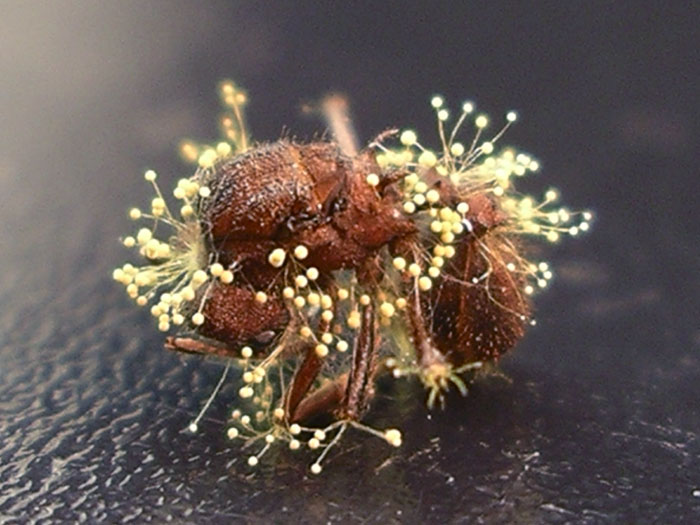There are few dead ants in the nest off to the side, with yellow mold growing on them.
Edited by AntsMAN, September 29 2016 - 5:09 PM.

There are few dead ants in the nest off to the side, with yellow mold growing on them.
Edited by AntsMAN, September 29 2016 - 5:09 PM.
Current queens/colonies
Camponotus novaeboracensis x2
Camponotus pennsylvanicus x2
Camponotus herculeanus x1
Formica sp. x1
Lasius americanus x1 (Lasius alienus)
Lasius neoniger x1
Crematogastor cerasi x1
Myrmica sp. x1
Current queens/colonies
Camponotus novaeboracensis x2
Camponotus pennsylvanicus x2
Camponotus herculeanus x1
Formica sp. x1
Lasius americanus x1 (Lasius alienus)
Lasius neoniger x1
Crematogastor cerasi x1
Myrmica sp. x1
I HATE that fungus. I get it all the time. I never saw it until the first time I brought home stuff from the desert. I think it's some sort of Aspergillus, and the worst thing about it is the fungus-eating organisms like springtails and booklice won't eat it.

I HATE that fungus. I get it all the time. I never saw it until the first time I brought home stuff from the desert. I think it's some sort of Aspergillus, and the worst thing about it is the fungus-eating organisms like springtails and booklice won't eat it.
If this is truly Aspergillus then it seems this kind of fungi is a huge problem. I found this excerpt from a section on it harming figs "Avoid creating excess dust or letting the trees become water stressed. Choose cultivars with a small ostiole. No chemical treatments are recommended for this disease. For dried figs, remove figs at the processing plant that show characteristic yellowish green fluorescence." It seems that there really is no treatment for it. I don't know what you could do to solve your fungi problem. I'm assuming in the wild ants have some way of protecting themselves form this kind of fungus.
Currently Keeping:
Trachymyrmex septentrionalis
Pheidole pilifera
Forelius sp. (Monogynous, bicolored) "Midwestern Forelius"
Crematogaster cerasi
Pheidole bicarinata
Aphaenogaster rudis
Camponotus chromaiodes
Formica sp. (microgena species)
Nylanderia cf. arenivega
Edited by spider_creations, September 30 2016 - 8:19 AM.
Why does things like this have to happen in ant keeping, like the wierd killer fungus, the white Acromyrmex eater fungus, mold.....black mold with stocks on them...i have only had the "Acromyrmex eater" fungus (named it some thing that would suit it) but I am really freaked out about getting this fungus
Natures checks and balances. When certain species become too abundant, there chances of bringing this mold into their nest is higher. Causes populations to die down, and the ants will move the infected as far from the nest as they can.
There's a mold that's specific to almost every single insect.
I can't remember the documentary, but one explains this fungus/mold pretty well.
From what I remember, these Aspergillus molds are opportunistic, not dedicated ant parasites. The spores are ever-present in the air and will colonize the ants if they're weak or dying. Healthy colonies shouldn't have much of a problem with them.
Current Species:
Camponotus fragilis
Novomessor cockerelli
Pogonomyrmex montanus
Pogonomyrmex rugosus
Manica bradleyi
From what I remember, these Aspergillus molds are opportunistic, not dedicated ant parasites. The spores are ever-present in the air and will colonize the ants if they're weak or dying. Healthy colonies shouldn't have much of a problem with them.
Exactly. This stuff doesn't' show up until the insect dies. I highly doubt a few spores are killing them.
Are you talking about Aspergillosis?
Yes.
Currently Keeping:
Trachymyrmex septentrionalis
Pheidole pilifera
Forelius sp. (Monogynous, bicolored) "Midwestern Forelius"
Crematogaster cerasi
Pheidole bicarinata
Aphaenogaster rudis
Camponotus chromaiodes
Formica sp. (microgena species)
Nylanderia cf. arenivega
It's grown 5x in 3 days, trying desperately to get them to move but they are so close to hibernating, they aren't very active.
I added heat to the other nest I attached and four of five worker are checking it out, I've left the infected nest dry. Hoping they move soon.
Current queens/colonies
Camponotus novaeboracensis x2
Camponotus pennsylvanicus x2
Camponotus herculeanus x1
Formica sp. x1
Lasius americanus x1 (Lasius alienus)
Lasius neoniger x1
Crematogastor cerasi x1
Myrmica sp. x1
0 members, 1 guests, 0 anonymous users